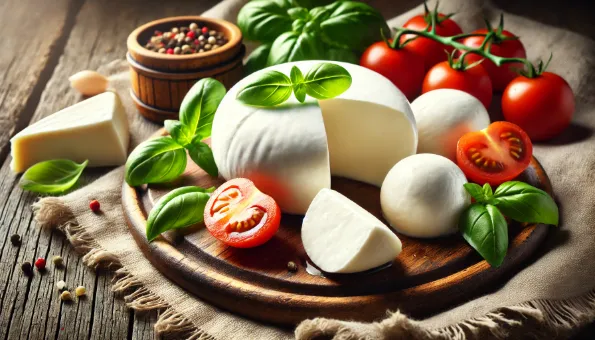Mozzarella: Creamy 6 g Protein + Calcium in Every Ounce
One 30 g slice delivers 85 kcal, 6 g complete protein and 14 % DV calcium—perfect for that gooey-stretch without excess carbs.

What Makes Mozzarella Unique?
Mozzarella is a **pasta-filata** cheese: fresh cow- or buffalo-milk curds are heated and stretched into elastic strands, trapping moisture for that signature milky pull. Sold fresh in brine (*fior di latte* or buffalo) or low-moisture for pizza, it melts evenly without breaking.
Nutrition per 30 g (1 oz) fresh
|Calories|Protein|Fat|Sat. Fat|Carbs|Calcium|Sodium|
|---|---|---|---|---|---|---|
|85 kcal|6 g|6 g|3.8 g|0.7 g|14 % DV|9 % DV|
Why Keep It in the Fridge
- **Complete protein** for muscle repair with minimal lactose.
- Rich in **calcium & phosphorus** for bone strength.
- Provides **conjugated linoleic acid (CLA)**—linked to anti-inflammatory effects.
- Lower sodium than most aged cheeses; mild flavour suits kids’ palates.
Drawbacks & Intolerances
- Contains **saturated fat & sodium**—portion control recommended (30–60 g).
- Not suitable for **lactose-intolerant** or dairy-allergic individuals.
- Fresh mozzarella spoils quickly; keep at ≤ 4 °C and use within 3–4 days after opening.
Culinary Ideas
- Classic **Caprese**: alternate slices with tomato & basil, drizzle EVOO.
- Grate low-moisture mozzarella for evenly browned **pizza**.
- Stuff into chicken breast with pesto for a 20-min bake.
- Tear over roasted veggies as a melted protein boost.
Buying & Storage
- Look for **snow-white, elastic balls** submerged in clear brine.
- “Buffalo” (water-buffalo milk) tastes richer; **cow-milk fior di latte** is milder.
- Keep submerged in its whey/brine; change liquid daily once opened.
- Freeze only low-moisture blocks—fresh texture degrades after thawing.
- 1. Mozzarella

